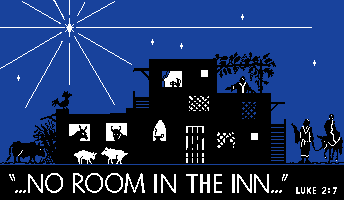Was Jesus born in a stable? a cave? a barn?

Away in a manger, but not a stable?
We know the Christmas story so well. Mary and Joseph traveled from Nazareth to Bethlehem and were turned away from the village inn by the innkeeper. They took refuge in a barn, where baby Jesus was born and laid in a manger. A very early church tradition says the site of the nativity was a cave near Bethlehem.
The Biblical story of the birth of Jesus is found primarily in Luke 2. Dr. Luke neither quotes nor mentions an innkeeper. We suggest the story does not refer to an inn, a cave or even a barn, but rather a house!
The text of Luke 2 notes there was no room for Mary and Joseph in the “inn.” Unfortunately, the Greek term translated inn (kataluma) had multiple meanings, among them inn or caravansary. Used only one other time in the New Testament (Luke 22:11 and the parallel passage, Mark 14:14), it was the place where Jesus observed the Last Supper with His disciples. Here, Dr. Luke gave additional information about the kataluma. He said it was a furnished large upper story room within a private Jerusalem house. The kataluma of the last night of Jesus’ Earthly ministry was the “upper room.”
We suggest the kataluma of Jesus’ first night was a similar room in Bethlehem. Mary and Joseph came into town with Mary ready to deliver. Arriving at Joseph’s ancestral home, they found it already full of other family members who had arrived earlier. While the exact reason space was not made for a pregnant woman is unknown, it probably indicates the house was full of elder members of Joseph’s family, who had priority.
So that is when Mary and Joseph went to the barn, right? Not exactly. The Biblical account mentions neither barn nor cave—it is assumed because of the manger. Mangers are animal feeding troughs, and barns are where one would expect to find them. But in the ancient world, as well as in primitive modern cultures, mangers are also found within the house itself. Animals are regularly kept in homes at night.
A small number of flock animals were housed, not in attached exterior sheds, but inside the house in one of the ground floor rooms. Here, animals, tools and agricultural produce were stored. Here, too, food was prepared and possibly consumed. Family sleeping quarters were on the second floor (an upper room). By being inside, the animals were protected from the elements and theft. In addition, their presence provided body heat for cool nights, access to milk for the daily meal and dung as a critical fuel source.
Excavations in Israel have uncovered numerous installations within domestic structures which probably represent ancient mangers. Some are carved, but most are stone built. Wooden mangers, of course, have not survived in the archaeological record.
Consequently, Mary and Joseph did not find space in the living quarters of the ancestral family home. Instead, they stayed downstairs in the domestic stable, still within the ancestral home, where a manger or two was located. Here they were visited by the shepherds, and maybe the wise men some time later.
For God so loved the world, that He gave His only begotten Son, that whosoever believeth in Him should not perish, but have everlasting life (John 3:16).

Author: Provided by Associates for Biblical Research, Faith Builder Card #2, available from ABR. Drawing at top by Gene Fackler, Associates for Biblical Research
Copyright © 1995, Associates for Biblical Research, All Rights Reserved—except as noted on attached “Usage and Copyright” page that grants ChristianAnswers.Net users generous rights for putting this page to work in their homes, personal witnessing, churches and schools.


